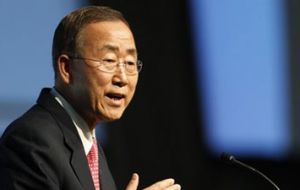MercoPress. South Atlantic News Agency
One third of all food produced fails to make it from farm to table, says UN
 Ban Ki-moon calls for “Think.Eat.Save: Reduce Your Foodprint” on WED
Ban Ki-moon calls for “Think.Eat.Save: Reduce Your Foodprint” on WED We live in a world of plenty, where food production outstrips demand, yet 870 million people are undernourished and childhood stunting is a silent pandemic. To create the future we want, we must correct this inequity.
We must ensure access to adequate nutrition for all, double the productivity of smallholder farmers who grow the bulk of food in the developing world, and make food systems sustainable in the face of environmental and economic shocks. This is the vision of my Zero Hunger Challenge, launched last year at the Rio+20 UN Conference on Sustainable Development.
One way to narrow the hunger gap and improve the well-being of the most vulnerable is to address the massive loss and waste inherent in today's food systems. Currently at least one third of all food produced fails to make it from farm to table. This is foremost an affront to the hungry, but it also represents a massive environmental cost in terms of energy, land and water.
In developing countries, pests, inadequate storage facilities and inefficient supply chains are major contributors to food loss. Those who grow for export are also often at the mercy of over-stringent expectations of buyers who place a premium on cosmetic perfection. In developed nations, food thrown away by households and the retail and catering industries rots in landfills, releasing significant quantities of methane, a powerful greenhouse gas.
Food loss and waste is something we can all address. That is why the United Nations Environment Program, the UN Food and Agricultural Organization and public and private sector partners have launched the “Think.Eat.Save: Reduce Your Foodprint” campaign to raise global awareness and showcase solutions relevant to developed and developing countries alike.
Infrastructure and technology can reduce the amount of food that perishes after it is harvested and before it reaches the market. Developing country governments can work to improve essential infrastructure and maximize trade opportunities with neighbours; developed nations can support fair trade and rationalize sell-by dates and other labelling systems; businesses can revise their criteria for rejecting produce; and consumers can minimize waste by buying only what they need and re-using left-over food.
On this World Environment Day, I urge all actors in the global food chain to take responsibility for environmentally sustainable and socially equitable food systems. The current global population of seven billion is expected to grow to nine billion by 2050. But the number of hungry people need not increase. By reducing food waste, we can save money and resources, minimize environmental impacts and, most importantly, move towards a world where everyone has enough to eat.




Top Comments
Disclaimer & comment rules-

-

Read all commentsAnd RGs GM soy ?
Jun 05th, 2013 - 09:53 am 0http://www.reuters.com/article/2013/06/04/argentina-soy-idUSL1N0EG1OK20130604?rpc=401&feedType=RSS&feedName=rbssIndustryMaterialsUtilitiesNews&rpc=401
@1 We try not to mention argieland's GM soy. It's a pretty sad story. It's provided by Monsanto, which has pretty close to a monpoly as it “invests” personally in CFK. Then there's the biological “experimentation” performed on the “peasants” with the chemicals sprayed on it. Birth defects, mental instability, psychological disorders, all that sort of stuff. Then, as your article mentions, the dropping protein content. Just imagine “soy sauce, with added protein”. And they even have trouble selling the stuff for biofuels! And the weather gods hate them.
Jun 05th, 2013 - 01:53 pm 0Commenting for this story is now closed.
If you have a Facebook account, become a fan and comment on our Facebook Page!